starters 预备篇(2012秋审查) Unit 1 Good morning !3a-4d课件
文档属性
| 名称 | starters 预备篇(2012秋审查) Unit 1 Good morning !3a-4d课件 | 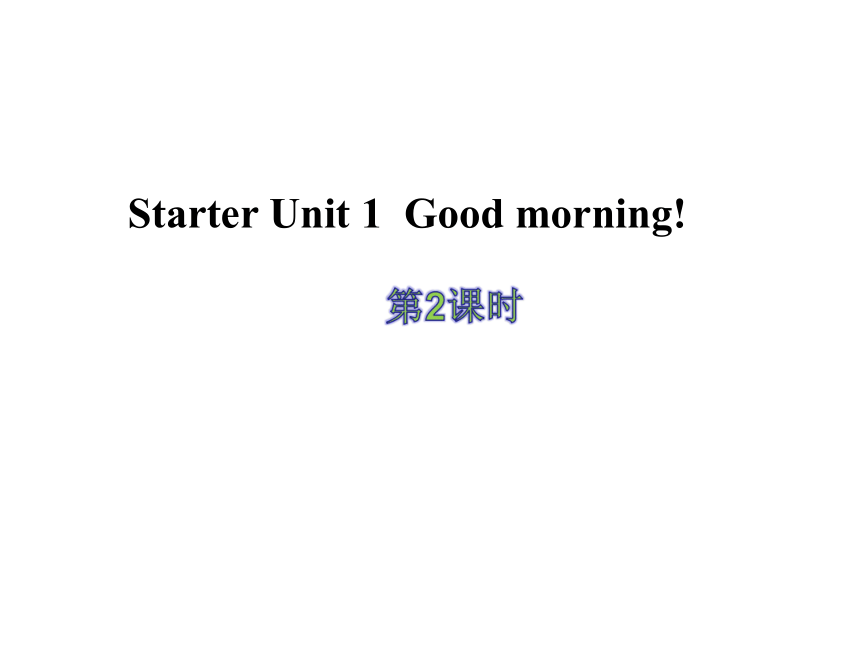 | |
| 格式 | zip | ||
| 文件大小 | 11.5MB | ||
| 资源类型 | 教案 | ||
| 版本资源 | 人教新目标(Go for it)版 | ||
| 科目 | 英语 | ||
| 更新时间 | 2017-11-27 19:49:02 | ||
图片预览

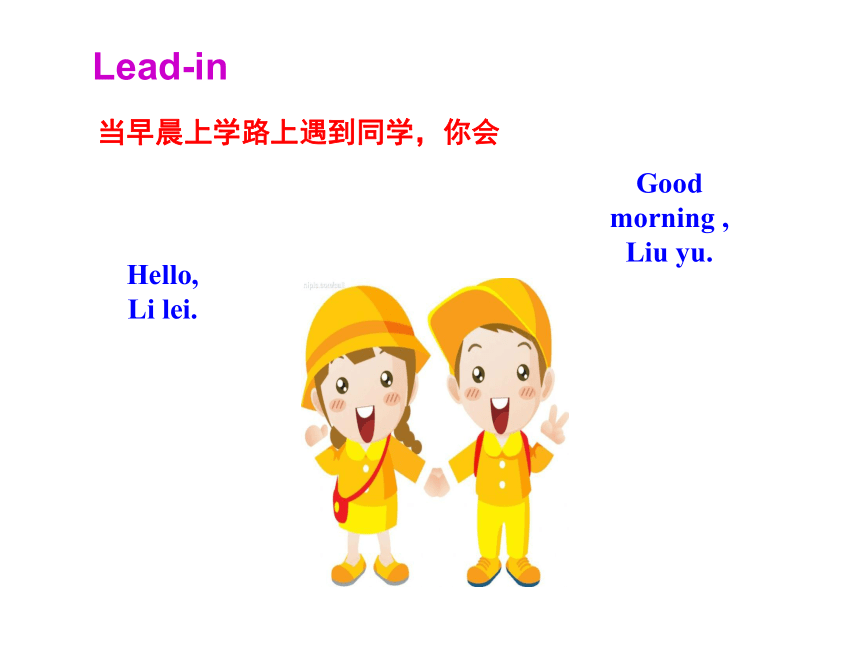
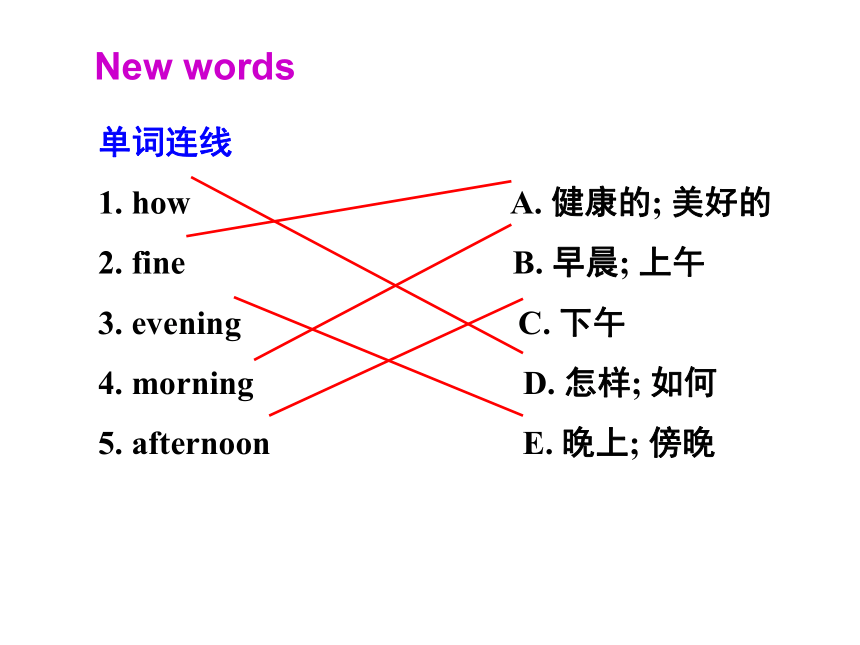
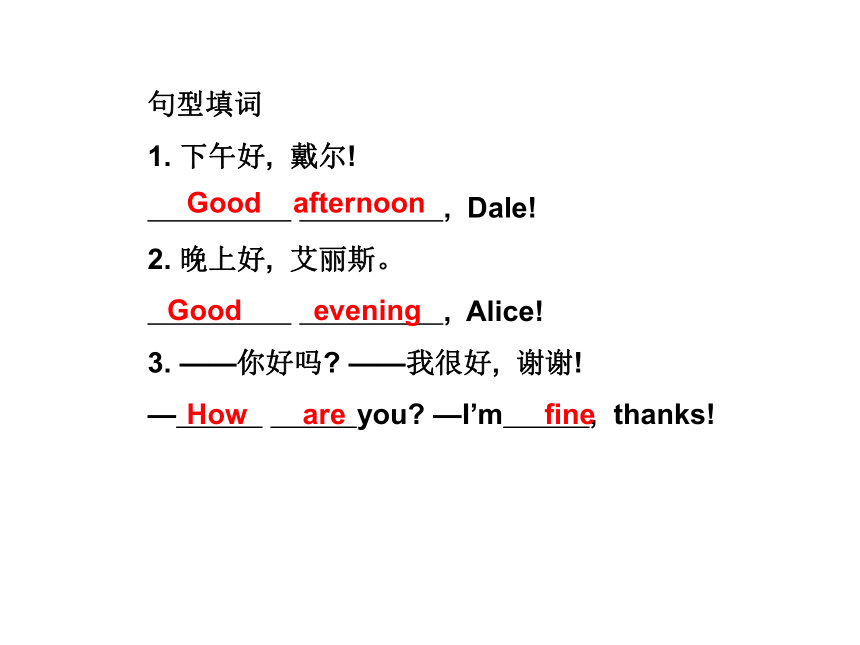

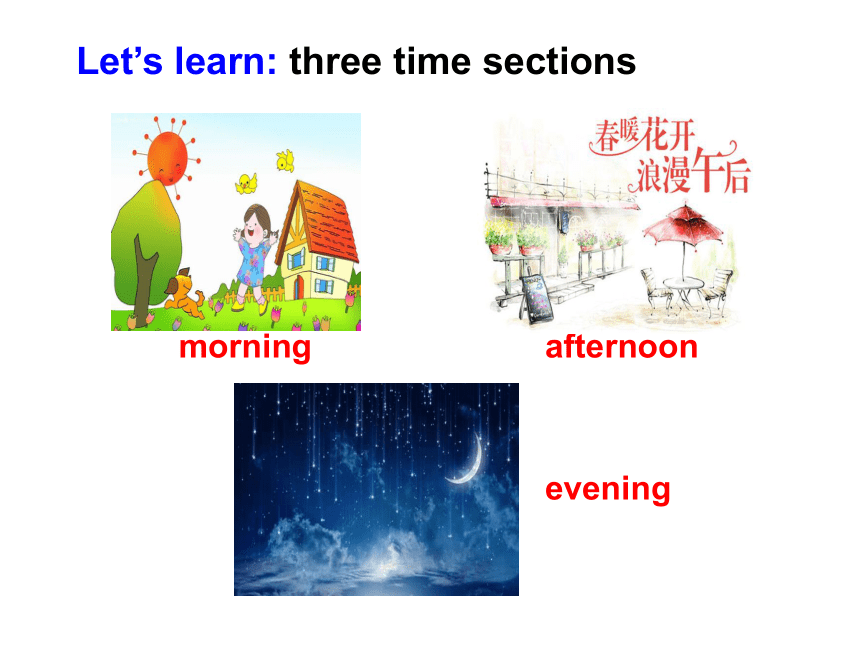

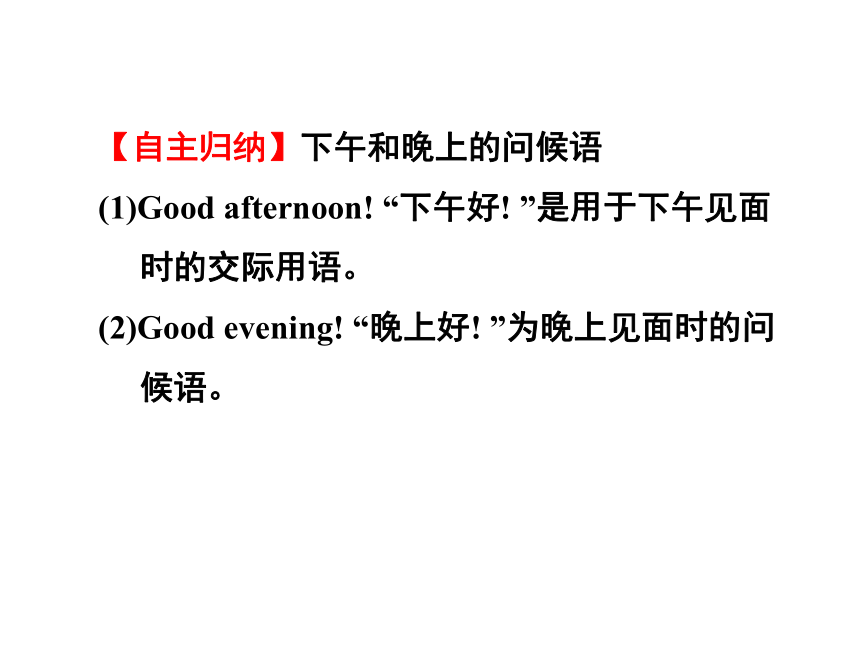
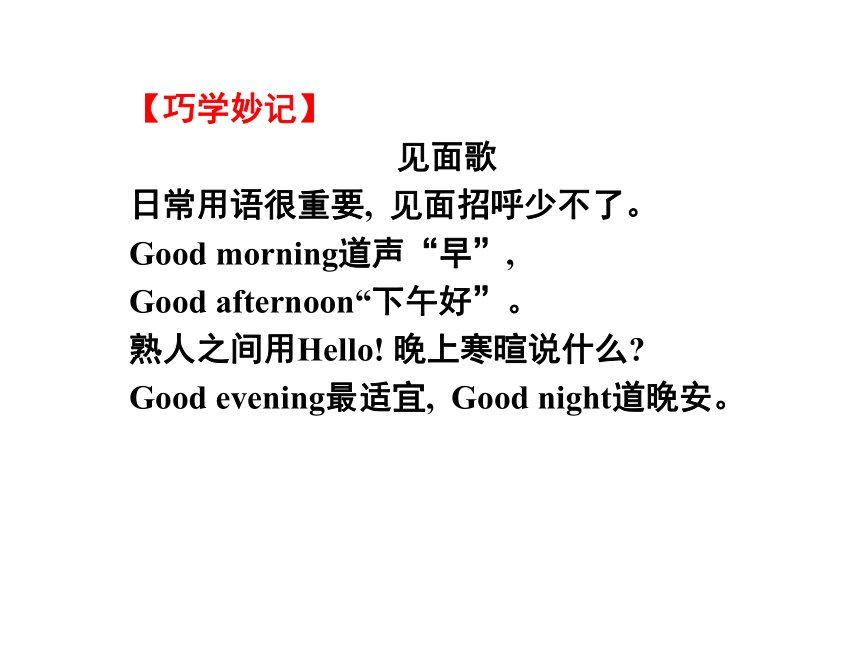
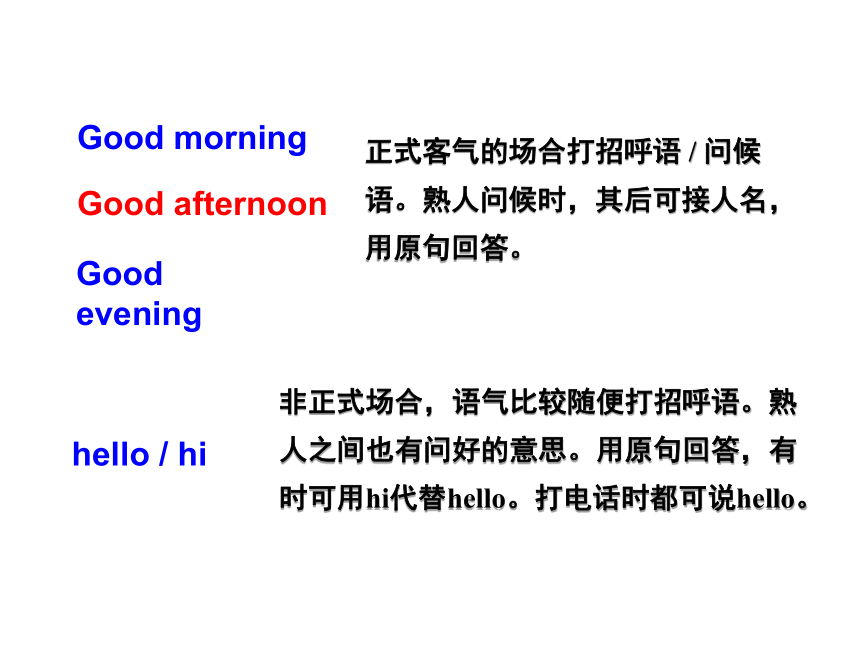
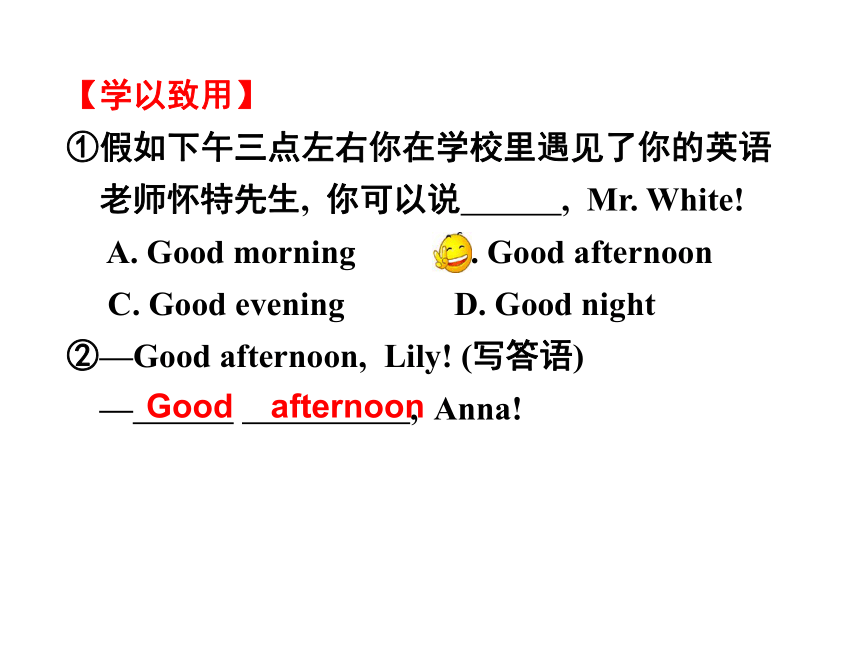
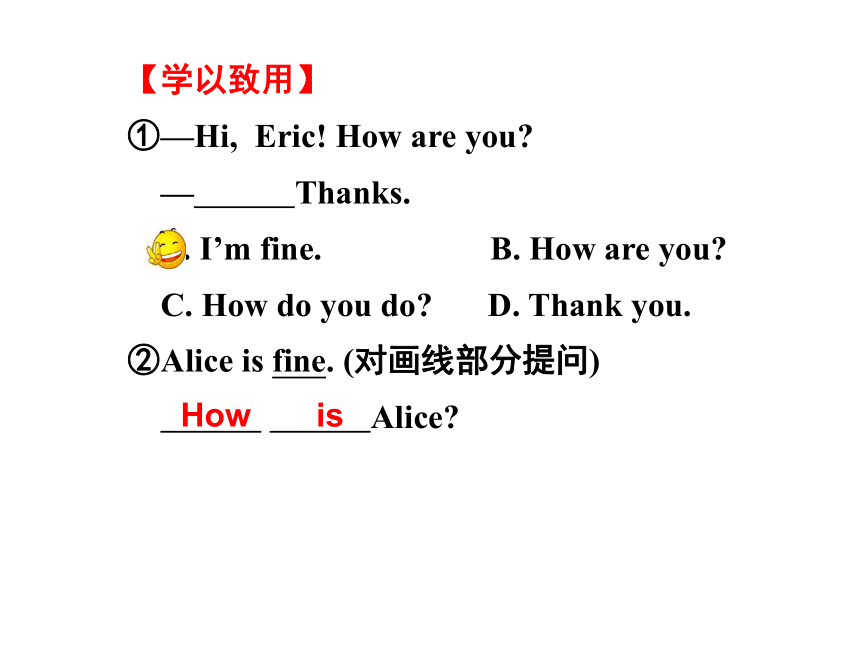
文档简介
课件43张PPT。Starter Unit 1 Good morning!第2课时 Lead-in 当早晨上学路上遇到同学,你会Hello, Li lei.Good morning , Liu yu.New words 5. 请please单词连线
1. how A. 健康的; 美好的
2. fine B. 早晨; 上午
3. evening C. 下午
4. morning D. 怎样; 如何
5. afternoon E. 晚上; 傍晚句型填词
1. 下午好, 戴尔!
, Dale!
2. 晚上好, 艾丽斯。
, Alice!
3. ——你好吗? ——我很好, 谢谢!
— you? —I’m , thanks! Good afternoonGood eveningHow are fine123Let’s learn: three time sectionsmorningafternoon evening Good afternoon! 下午好!
【语境领悟】
*Good afternoon, Eric! 下午好, 埃里克!
*Good evening, Bob! 晚上好, 鲍勃! Language points【自主归纳】下午和晚上的问候语
(1)Good afternoon! “下午好! ”是用于下午见面
时的交际用语。
(2)Good evening! “晚上好! ”为晚上见面时的问
候语。【巧学妙记】
见面歌
日常用语很重要, 见面招呼少不了。
Good morning道声“早”,
Good afternoon“下午好”。
熟人之间用Hello! 晚上寒暄说什么?
Good evening最适宜, Good night道晚安。Good morningGood afternoonGood evening正式客气的场合打招呼语 / 问候语。熟人问候时,其后可接人名,用原句回答。hello / hi非正式场合,语气比较随便打招呼语。熟人之间也有问好的意思。用原句回答,有时可用hi代替hello。打电话时都可说hello。【学以致用】
①假如下午三点左右你在学校里遇见了你的英语
老师怀特先生, 你可以说 , Mr. White!
A. Good morning B. Good afternoon
C. Good evening D. Good night
②—Good afternoon, Lily! (写答语)
— , Anna!Good afternoon【学以致用】
①—Hi, Eric! How are you?
— Thanks.
A. I’m fine. B. How are you?
C. How do you do? D. Thank you.
②Alice is fine. (对画线部分提问)
Alice? How isRole-play 7:00 amGood morning!Good morning!Good afternoon!Good afternoon! 15:00Good evening!Good evening! 19:001. How are you? 你好吗?
【句型剖析】
“How are you? ”常用来询问对方的身体状况, 其答语为“I’m fine, thank you. ”或“Fine, thanks. And you? ”。并向对方问好。Language points【语境领悟】
—How are you, Bob? 你好吗, 鲍勃?
—I’m fine, thanks. And you? 我很好, 谢谢。你
好吗?
—I’m fine, too. 我也很好。【归纳拓展】问候语的用法用于熟人之间,询问对方的身体状况I’m fine/well/OK,
thanks/thank you.用于正式场合,成年人初次见面时How do you do?2. OK interj. &adv. 好; 可以
【语境领悟】
I’m OK. 我很好。
【自主归纳】OK的用法
OK在英语中也可以写成okay, 在此句中OK指身
体状况好。【归纳拓展】 OK还可以用于下面情况【学以致用】
①—Let’s go home.
— .
A. Thanks B. I’m fine
C. Sorry D. OK
②—How is Bob?
— ?
A. Good morning! B. He is OK.
C. He is 15. D. He’s a boy. A: Hi, Helen! How are you?
B:Hi, Eric! I’m fine, thinks. Choose one nameCindyBobEricHelenDaleFrankGraceAliceAliceBobCindyDaleEricFrankGraceHelen按性别分类:(不可混用)boy (男孩):girl (女孩):Name List
_______________
_______________ _______________ _______________ _______________ _______________ _______________
_______________AliceBobCindyDaleEricFrankGraceHelen我们发现:
Aa
[ei] [ei][?][ei]cake grape name
snake face baby[?]have apple bag
cat hat fat我们发现:
Ee
[i:] [i:][e][ i:]发音要诀:舌尖抵下齿,舌前部
向硬腭尽量抬起,上下唇以及齿靠
近但不接触。舌头与唇肌拉紧将这
个音发出并且拉长。嘴唇向两边张
开成微笑状。 [e] 舌尖抵下齿,
舌前部稍微抬起,
嘴不要张太大,上
下齿间距宁可偏小。 [i:]we me she
tree sheep Chinese[e]leg desk seven
yes eleven 一、good morning, 常用于早晨或上午(中午12点之前)
向他人问候。如果对方是我们熟悉的人,还可以说:
“Morning!”。当然,还可以用“Hello!”或“Hi!”来打
招呼。回答时,可以重复对方的话,也可以向其进行
问候。在不同的时间段,还可以说:Good afternoon!
下午好! Good evening! 晚上好!问候他人Summary 二、hello是人们见面时常用的问候语,有时为了引起对方
注意也用hello, 意为“喂”、“你好”。hi可与之互换,
不过,hi比hello更常用,显得更亲近、随和。它们都
用于口语,使用时不受时间的限制。英美人一般在打
招呼时,也说称呼语。如:Hi, Dale! 喂,戴尔!需要
大家注意的是,在打电话时,多用hello, 而很少用hi。
另外,还要注意的是,对老师、上级、年长者以及有
身份地位的人打招呼时,一般不用hello或hi,以免对
其不尊重。 三、How are you? 是英美国家较熟悉的人之间见面时常用的问候语,但并不是想深入交谈某人的健康状况,只是一种礼貌的问候方式,常见的答语为:Fine, thank you. / Very well. ( I’m OK. / I’m all right. ) thank you./ Thanks.
出于礼貌并常加上一句 And you? (你呢?)来询问对方。这时,可以用:I’m fine, too./ Fine, too./
Not (too) bad, thank you.等作答。 一、补全对话, 每空一词。
Mary: Good afternoon!
Tom: 1 2 ! 3 are you?
Mary: I’m 4 , 5 . And 6 ?
Tom: I’m 7 , too.
1. 2. 3. 4. ?
5. 6. 7. ?GoodafternoonHowfine/OK thanksyoufine/OKExercise F H二、看图片,在四线三格中写出所给字母的左邻右舍。 A CD FB DE G三、将方框中的单词归入字典A-H栏中。
a: __________ 2. b: ___________
3. c: ___________ 4. d: ___________
5. e: ___________ 6. f: ____________
7. g: ___________ 8. h: ____________ Alice areBob byeCD CindyDale doevening Ericfive fatherHelen, green, Alice, five, Bob, CD, evening, bye , are, Dale, English, father, do, good, hello, Cindy, Eric green goodHelen hello
1. how A. 健康的; 美好的
2. fine B. 早晨; 上午
3. evening C. 下午
4. morning D. 怎样; 如何
5. afternoon E. 晚上; 傍晚句型填词
1. 下午好, 戴尔!
, Dale!
2. 晚上好, 艾丽斯。
, Alice!
3. ——你好吗? ——我很好, 谢谢!
— you? —I’m , thanks! Good afternoonGood eveningHow are fine123Let’s learn: three time sectionsmorningafternoon evening Good afternoon! 下午好!
【语境领悟】
*Good afternoon, Eric! 下午好, 埃里克!
*Good evening, Bob! 晚上好, 鲍勃! Language points【自主归纳】下午和晚上的问候语
(1)Good afternoon! “下午好! ”是用于下午见面
时的交际用语。
(2)Good evening! “晚上好! ”为晚上见面时的问
候语。【巧学妙记】
见面歌
日常用语很重要, 见面招呼少不了。
Good morning道声“早”,
Good afternoon“下午好”。
熟人之间用Hello! 晚上寒暄说什么?
Good evening最适宜, Good night道晚安。Good morningGood afternoonGood evening正式客气的场合打招呼语 / 问候语。熟人问候时,其后可接人名,用原句回答。hello / hi非正式场合,语气比较随便打招呼语。熟人之间也有问好的意思。用原句回答,有时可用hi代替hello。打电话时都可说hello。【学以致用】
①假如下午三点左右你在学校里遇见了你的英语
老师怀特先生, 你可以说 , Mr. White!
A. Good morning B. Good afternoon
C. Good evening D. Good night
②—Good afternoon, Lily! (写答语)
— , Anna!Good afternoon【学以致用】
①—Hi, Eric! How are you?
— Thanks.
A. I’m fine. B. How are you?
C. How do you do? D. Thank you.
②Alice is fine. (对画线部分提问)
Alice? How isRole-play 7:00 amGood morning!Good morning!Good afternoon!Good afternoon! 15:00Good evening!Good evening! 19:001. How are you? 你好吗?
【句型剖析】
“How are you? ”常用来询问对方的身体状况, 其答语为“I’m fine, thank you. ”或“Fine, thanks. And you? ”。并向对方问好。Language points【语境领悟】
—How are you, Bob? 你好吗, 鲍勃?
—I’m fine, thanks. And you? 我很好, 谢谢。你
好吗?
—I’m fine, too. 我也很好。【归纳拓展】问候语的用法用于熟人之间,询问对方的身体状况I’m fine/well/OK,
thanks/thank you.用于正式场合,成年人初次见面时How do you do?2. OK interj. &adv. 好; 可以
【语境领悟】
I’m OK. 我很好。
【自主归纳】OK的用法
OK在英语中也可以写成okay, 在此句中OK指身
体状况好。【归纳拓展】 OK还可以用于下面情况【学以致用】
①—Let’s go home.
— .
A. Thanks B. I’m fine
C. Sorry D. OK
②—How is Bob?
— ?
A. Good morning! B. He is OK.
C. He is 15. D. He’s a boy. A: Hi, Helen! How are you?
B:Hi, Eric! I’m fine, thinks. Choose one nameCindyBobEricHelenDaleFrankGraceAliceAliceBobCindyDaleEricFrankGraceHelen按性别分类:(不可混用)boy (男孩):girl (女孩):Name List
_______________
_______________ _______________ _______________ _______________ _______________ _______________
_______________AliceBobCindyDaleEricFrankGraceHelen我们发现:
Aa
[ei] [ei][?][ei]cake grape name
snake face baby[?]have apple bag
cat hat fat我们发现:
Ee
[i:] [i:][e][ i:]发音要诀:舌尖抵下齿,舌前部
向硬腭尽量抬起,上下唇以及齿靠
近但不接触。舌头与唇肌拉紧将这
个音发出并且拉长。嘴唇向两边张
开成微笑状。 [e] 舌尖抵下齿,
舌前部稍微抬起,
嘴不要张太大,上
下齿间距宁可偏小。 [i:]we me she
tree sheep Chinese[e]leg desk seven
yes eleven 一、good morning, 常用于早晨或上午(中午12点之前)
向他人问候。如果对方是我们熟悉的人,还可以说:
“Morning!”。当然,还可以用“Hello!”或“Hi!”来打
招呼。回答时,可以重复对方的话,也可以向其进行
问候。在不同的时间段,还可以说:Good afternoon!
下午好! Good evening! 晚上好!问候他人Summary 二、hello是人们见面时常用的问候语,有时为了引起对方
注意也用hello, 意为“喂”、“你好”。hi可与之互换,
不过,hi比hello更常用,显得更亲近、随和。它们都
用于口语,使用时不受时间的限制。英美人一般在打
招呼时,也说称呼语。如:Hi, Dale! 喂,戴尔!需要
大家注意的是,在打电话时,多用hello, 而很少用hi。
另外,还要注意的是,对老师、上级、年长者以及有
身份地位的人打招呼时,一般不用hello或hi,以免对
其不尊重。 三、How are you? 是英美国家较熟悉的人之间见面时常用的问候语,但并不是想深入交谈某人的健康状况,只是一种礼貌的问候方式,常见的答语为:Fine, thank you. / Very well. ( I’m OK. / I’m all right. ) thank you./ Thanks.
出于礼貌并常加上一句 And you? (你呢?)来询问对方。这时,可以用:I’m fine, too./ Fine, too./
Not (too) bad, thank you.等作答。 一、补全对话, 每空一词。
Mary: Good afternoon!
Tom: 1 2 ! 3 are you?
Mary: I’m 4 , 5 . And 6 ?
Tom: I’m 7 , too.
1. 2. 3. 4. ?
5. 6. 7. ?GoodafternoonHowfine/OK thanksyoufine/OKExercise F H二、看图片,在四线三格中写出所给字母的左邻右舍。 A CD FB DE G三、将方框中的单词归入字典A-H栏中。
a: __________ 2. b: ___________
3. c: ___________ 4. d: ___________
5. e: ___________ 6. f: ____________
7. g: ___________ 8. h: ____________ Alice areBob byeCD CindyDale doevening Ericfive fatherHelen, green, Alice, five, Bob, CD, evening, bye , are, Dale, English, father, do, good, hello, Cindy, Eric green goodHelen hello
同课章节目录
- starters 预备篇(2012秋审查)
- Unit 1 Good morning !
- Unit 2 What’s this in English?
- Unit 3 What color is it ?
- Unit 1 My name's Gina.
- Section A
- Section B
- Unit 2 This is my sister.
- Section A
- Section B
- Unit 3 Is this your pencil?
- Section A
- Section B
- Unit 4 Where's my schoolbag?
- Section A
- Section B
- Unit 5 Do you have a soccer ball?
- Section A
- Section B
- Unit 6 Do you like bananas?
- Section A
- Section B
- Unit 7 How much are these socks?
- Section A
- Section B
- Unit 8 When is your birthday?
- Section A
- Section B
- Unit 9 My favorite subject is science.
- Section A
- Section B
